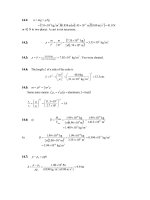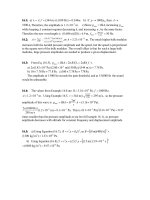- Trang chủ >>
- Khoa Học Tự Nhiên >>
- Vật lý
Tài liệu Physics exercises_solution: Chapter 20 pptx
Bạn đang xem bản rút gọn của tài liệu. Xem và tải ngay bản đầy đủ của tài liệu tại đây (229.21 KB, 25 trang )
20.1: a)
%.8.33338.0b) J.6500J4300J2200
6500
2200
20.2: a)
%.9.28289.0b) J.2600J6400J9000
J9000
J2600
20.3: a)
%.0.23230.0
100,16
3700
b)
J.12,400J3700J100,16
c)
.g350.0
kgJ1060.4
J100,16
4
d)
hp.298kW222s)60.0J)(3700(
20.4: a)
J.1043.6
5
)280.0(
s)W)(1.0010180(
1
3
PtQ
e
b)
J.104.63s)W)(1.0010180(J1043.6
535
PtQ
20.5: a)
MW.970MW330MW1300b) %.2525.0
MW1300
MW330
e
20.6: Solving
,for (20.6)Eq. r
or )1ln(ln)1( erγ
.8.13)350.0()1(
5.2
1
1
γ
er
If the first equation is used (for instance, using a calculator without the
y
x
function), note
that the symbol “e” is the ideal efficiency , not the base of natural logarithms.
20.7: a)
C.453K726K)(9.5)15.295(
0.401
γ
ab
rTT
b)
Pa.1099.1Pa)(9.50)1050.8(
64
γγ
ab
rpp
20.8: a) From
%.5858.0)8.8(11 (20.6),Eq.
40.01
γ
re
b)
%,60)6.9(1
40.0
an increase of 2%. If more figures are kept for the
efficiencies, the difference is 1.4%.
20.9: a)
J.1062.1
4
10.2
J1040.3
4
K
Q
C
W
b)
J.1002.5)1(
4
1
CCH
K
QWQQ
20.10:
)(
1
f
C
TcL
t
m
KtK
Q
t
W
P
p
W.128K)K)(2.5kgJ(485kg)J1060.1(
s3600
kg0.8
8.2
1
5
20.11: a)
,b) W.767
s0.60
J1080.9J1044.1
45
PHEER
or
.27.7)413.3(
W767
W1633
)413.3(
]s)(60J)108.9(s)(60J)1044.1([
s)(60J)108.9(
45
4
EER
20.12: a)
)(
waterwatericeiceC
TcTcLmQ
f
J.1090.8
K)K)(25.0kgJ4190(K)K)(5.0kgJ2100(kgJ10334kg)80.1(
5
3
b)
J.1037.3
5
40.2
J1008.8
||
5
C
K
Q
W
c)
|| that (noteJ101.14J108.08J1037.3||||
H
655
CH
QQWQ
).)1(||
1
C
K
Q
20.13: a)
J.215J335J550||||
CH
b)
K.378J)550JK)(335620(|)|||(
HCHC
QQTT
c)
%.39J)550J335(1)||||(1
HC
20.14: a) From Eq. (20.13), the rejected heat is
J.103.72J)6450)((
3
K520
K300
b)
J.102.73J103.72J6450
33
c) From either Eq. (20.4) or Eq. (20.14), e=0.423=42.3%.
20.15: a)
C
H
f
C
H
CH
||||
T
T
mL
T
T
J,10088.3
K)(273.15
K)(287.15
kg)J10kg)(3340.85(
73
or
))(1(||||||||b) figures. two toJ1009.3
HHCH
7
TTQQQW
C
J)1009.3(
7
J.1049.2))15.29715.273(1(
6
20.16: a) From Eq. (20.13),
J.492J)415)((
K270
K320
b) The work per cycle is
J,77J415J492
and
W,212)75.2(
s1.00
J77
P
keeping an extra figure.
c)
5.4.K)(50K)270()(
CHC
TTT
20.17: For all cases,
.||||||
CH
QQW
a) The heat is discarded at a higher
temperature, and a refrigerator is required;
J)1000.5()1)((||||
3
CHC
TTQW
J.665)1)15.263298.15((
b) Again, the device is a refrigerator, and
J.190)1)15.263/15.273((||||
C
QW
c) The device is an engine; the heat is taken
form the hot reservoir, and the work done by the engine is
J)1000.5(||
3
W
J.285)1)15.263248.15((
20.18: For the smallest amount of electrical energy, use a Carnot cycle.
J102.09
K)J10kg)(334(5.00K)20(4190kg)(5.00
6
3
Kkg
J
F waterfreezeC0 water toCoolin
mLTmcQQQ
Carnot cycle:
K293K268
J1009.2
out
6
hot
out
cold
in
Q
T
Q
T
Q
room) theJ(into1028.2
6
out
Q
J1009.2J1028.2
66
inout
QQW
energy)alJ(electric1095.1
5
W
20.19: The total work that must be done is
J104.90m)100)(smkg)(9.80500(
52
tot
mgyW
J250
H
Q
Find
C
Q
so can calculate work
W
done each cycle:
H
T
T
Q
Q
C
H
C
J7.120K)(773.15K)(373.15J)250()(
HHCC
QTTQ
J3.129
HC
QQW
The number of cycles required is
cycles.3790
J3.129
J1009.4
5
tot
W
W
20.20: For a heat engine,
J,7500600.01)J3000(1/
CH
eQQ
J.4500)J7500)(600.0( then and
H
eQW
This does not make use of the given value
of
K 320600.01K8001engine,Carnot afor then used,isIf .
HCHH
eTTTT
,/and
CHCH
TTQQ
which gives the same result.
20.21:
J10336.1J/kg10334kg0400.0
43
fC
mLQ
J1089.4
J10825.1K15.273K373.15J10336.1
3
HC
44
CCHH
H
C
H
C
QQW
QTTQ
T
T
Q
Q
20.22: The claimed efficiency of the engine is
.%58
J1060.2
J1051.1
8
8
While the most efficient
engine that can operate between those temperatures has efficiency
%.381
K400
K250
Carnot
e
The proposed engine would violate the second law of thermodynamics, and is not likely to
find a market among the prudent.
20.23: a) Combining Eq. (20.14) and Eq. (20.15),
.
1
11
1
/1
/
HC
HC
e
e
e
e
TT
TT
K
b) As
),0(heat noexhaustsengine)1(perfect a;0,1
C
QeKe
and this is
useless as a refrigerator. As
)0(uselessa;,0 eKe
engine does no work
),0( W
and a refrigerator that requires no energy input is very good indeed.
20.24:
.KJ428
k15.273
kgJ10334kg350.0
a)
3
C
f
C
T
mL
T
Q
.KJ392
K298.15
J1017.1
b)
5
c)
K.J36)KJ392(KJ428 S
(If more figures are kept in the
intermediate calculations, or if
K))298.151(K)15.2731(( QS
K.J35.6used,is S
20.25: a) Heat flows out of the
C0.80
water into the ocean water and the
C0.80
water cools to
C0.20
(the ocean warms, very, very slightly). Heat flow for an isolated
system is always in this direction, from warmer objects into cooler objects, so this
process is irreversible.
b)
kg100.0
of water goes form
TmcQisflowheat theandC20.0 toC0.80
J102.154)60.0CK)(kgJkg)(4190(0.100
4
This Q comes out of the 0.100 kg of water and goes into the ocean.
For the 0.100 kg of water,
KJ78.02353.15)293.15ln(K)kgJkg)(4190100.0()ln(
12
TTmcS
For the ocean the heat flow is
J10154.2
4
Q
and occurs at constant T:
KJ76.85
K293.15
J10154.2
4
T
Q
S
KJ7.7KJ85.76KJ02.78
oceanwaternet
SSS
20.26: (a) Irreversible because heat will not spontaneously flow out of 15 kg of water into
a warm room to freeze the water.
(b)
roomice
SSS
room
F
ice
F
T
mL
T
mL
K293
kg)J10kg)(3340.15(
K273
)kgJ10kg)(3340.15(
33
KJ250,1
This result is consistent with the answer in (a) because
0S
for irreversible processes.
20.27: The final temperature will be
C,60
kg)(3.00
C)kg)(80.0(2.00C)kg)(20.000.1(
and so the entropy change is
K.J4.47
K353.15
K333.15
ln kg)00.2(
K293.15
K333.15
ln kg)(1.00K)kgJ4190(
20.28: For an isothermal expansion,
K.J31.6isentropy ofchangeThe.and0,0
K293.15
J1850
T
Q
WQUT
20.29: The entropy change is
.and,
v
mLQ
T
Q
S
Thus,
K.J644
K)216.4(
)kgJ10kg)(2.0913.0(
4
T
mL
S
v
20.30: a)
K.J1005.6
3
K)15.373(
)kgJ10kg)(225600.1(
3
v
T
mL
T
Q
S
Note that this is the change
of entropy of the water as it changes to steam. b) The magnitude of the entropy change
is roughly five times the value found in Example 20.5. Water is less ordered (more
random) than ice, but water is far less random than steam; a consideration of the density
changes indicates why this should be so.
20.31: a)
K.J109
K)15.373(
)kgJ10kg)(2256100.18(
33
v
T
mL
T
Q
S
b)
KJ8.72
K)34.77(
kg)J10kg)(201100.28(
:N
33
2
KJ2.102
K)2466(
kg)J10kg)(233610(107.9
:Ag
33
KJ6.86
K)630(
kg)J10kg)(27210(200.6
:Hg
33
c) The results are the same order or magnitude, all around
KJ100
.The entropy
change is a measure of the increase in randomness when a certain number (one mole)
goes from the liquid to the vapor state. The entropy per particle for any substance in a
vapor state is expected to be roughly the same, and since the randomness is much higher
in the vapor state (see Exercise 20.30), the entropy change per molecule is roughly the
same for these substances.
20.32: a) The final temperature, found using the methods of Chapter 17, is
C,94.28
K)kgJkg)(4190(0.800K)kgJkg)(39050.3(
)CK)(100kgJkg)(39050.3(
T
or
C9.28
to three figures. b) Using the result of Example 20.10, the total change in
entropy is (making the conversion to Kelvin temperature)
K.J2.49
K273.15
K302.09
ln K)kgJkg)(4190800.0(
K373.15
K302.09
ln K)kgJkg)(39050.3(
S
(This result was obtained by keeping even more figures in the intermediate calculation.
Rounding the Kelvin temperature to the nearest
K01.0
gives the same result.
20.33: As in Example 20.8,
K.J 74.6
m0280.0
m0.0420
ln K)molJ5mol)(8.31400.2(ln
3
3
1
2
V
V
nRS
20.34: a) On the average, each half of the box will contain half of each type of
molecule, 250 of nitrogen and 50 of oxygen. b ) See Example 20.11. The total change in
entropy is
ln(2))(ln(2)ln(2)
2121
kNNkNkNS
K.J105.74ln(2)K)J10381.1)(600(
2123
c) See also Exercise 20.36. The probability is
,104.2212121
181
600100500
and is not likely to happen.
The numerical result for part (c) above may not be obtained directly on some
standard calculators. For such calculators, the result may be found by taking the log base
ten of 0.5 and multiplying by 600, then adding 181 and then finding 10 to the power of
the sum. The result is then
.104.21010
18187.0181
20.35: a) No; the velocity distribution is a function of the mass of the particles, the
number of particles and the temperature, none of which change during the isothermal
expansion. b) As in Example 20.11,
2
3
1
1
ww
N
(the volume has increased, and
12
ww
);
andln(3),)(3ln)ln(
12
Nww
N
K.J18.3ln(3))3ln(ln(3) nRknNkNS
A
c) As in Example 20.8,
ln(3),ln
12
nRVVnRS
the same as the expression used in
part (b), and
K.J3.18S
20.36: For those with a knowledge of elementary probability, all of the results for this
exercise are obtained from
,
2
1
)!4(!
!4
)1()(
4
kk
ppkP
knkn
k
where P(k) is the probability of obtaining k heads,
2
1
1and4 ppn
for a fair coin.
This is of course consistent with Fig. (20.18).
a)
16
1
4
!4!0
!4
4
!0!4
!4
2121
for all heads or all tails. b)
.21
4
1
!3!1
!4
4
!1!3
!4
c)
.21
8
3
4
2!2!
4!
d)
.122
8
3
4
1
16
1
The number of heads must be one of 0, 1, 2, 3 or
4, and there must be unit probability of one and only one of these possibilities.
20.37: a)
J300 J,400
H
WQ
J100 so ,
HCHC
QWQQQW
Since it is a Carnot cycle,
H
C
H
C
T
T
Q
Q
C73K200J)(400J)100(K)15.800()(
HC
HC
QQTT
cycles1034.3
cycleJ100
J103.34
isrequiredcyclesofnumber theso J,100iscycleonefor
J1034.3kgJ10334kg0.10isrequiredTotalb)
4
6
63
fC
C
Q
mLQ
20.38: a) Solving Eq. (20.14) for
,1
1
,
CHH
e
TTT
so the temperature change
K.8.27
600.0
1
55.0
1
K15.183
1
1
1
1
CHH
ee
TTT
b) Similarly,
H,HHC
ifand,1 TTeTT
K.3.15
600.0
050.0
K15.183
1
CCC
e
ee
TTT
20.39: The initial volume is
.m1062.8
33
1
1
1
p
nRT
V
a) At point 1, the pressure
is given as atmospheric, and
Pa,1001.1
5
1
p
with the volume found above,
1
V
Pa1003.22and,m1062.8.m1062.8
5
112
33
12
33
1
2
pppVV
T
T
%.50500.01isefficiency thermal theK,600and
K 300between operatingenginecycle-CarnotaFor %.4.10104.0e)
J.227J1956J2183iscycleonefor engine theintoflowheat the2,-1processthe
for nscalculatioin thefiguresextraKeepingd) J.227J559J786isdonenet work
Thec) .J1956)K192)(KmolJ3145.8)(27)(mol350.0(
andJ1397)K192)(KmolJ3145.8)(25( J,559
)K192)(KmolJ3145.8)(mol350.0(isobaric;is1-3 process
The0).(J786)K108)(KmolJ3145.8)(25)(mol350.0(
and ,0adiabatic,is3-2processTheJ.1018.2K300KJ/mol3145.8
25mol350.0.0so0isochoric,is2-1Processb)
.m1041.1andPa1001.1Pa).10013.1using(
600
300
J2183
J227
3
32
13
5
13
5
1
3
e
WUTnC
QnTnCU
TnRVpW
WTnCW
UQ
TnCQUWV
VVppp
p
V
V
V
T
T
a
20.40: (a) The temperature at point c is
,fromsinceK 1000 nRTpVT
c
the maximum
temperature occurs when the pressure and volume are both maximum. So
mol.16.2
K1000KmolJ3145.8
m0300.0Pa1000.6
35
c
cc
RT
Vp
n
(b) Heat enters the gas along paths ab and bc, so the heat input per cycle is
H
Q
.
acacac
UWQ
Path ab has constant volume and path bc has constant pressure, so
J.1020.1)m0100.0m0300.0)(Pa1000.6()(0
4335
bccbcabac
VVpWWW
For an ideal gas,
mol.K,J46.28,COFor .using,)()T(
2
VaaccVacVac
CRpVnTRVpVpCTnCU
so
48.5))mPa)(0.01001000.2()mPa)(0.03001000.6((
KmolJ3145.8
KmolJ46.28
3535
ac
U
Then
J.106.68J105.48J1020.1
444
H
Q
(c) Heat is removed from the gas along paths cd and da, so the waste heat per cycle is
.
cacacaC
UWQQ
Path cd has constant volume and path da has constant pressure,
so
J.10400.0)m0300.0mPa)(0.01001000.2()(0
4335
daddacdca
VVpWWW
From (b),
J.105.88J105.48J100.400so J,1048.5
444
C
4
QUU
acca
(d) The work is the area enclosed by the rectangular path abcd,
J.8000J105.86J1068.6or ),)((
44
CH
QQWVVppW
acac
(e)
0.120.J)10(6.68J)8000(
4
H
QWe









